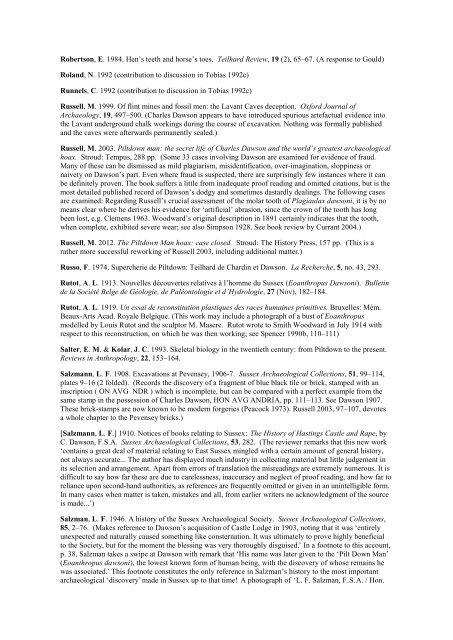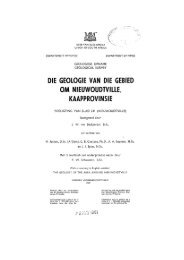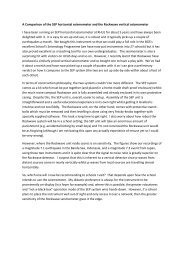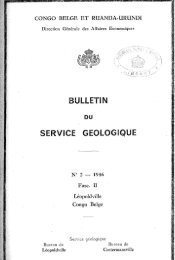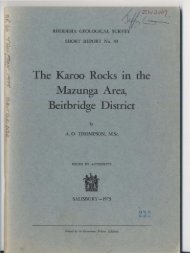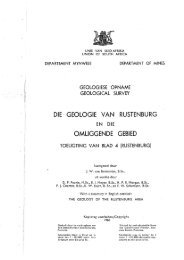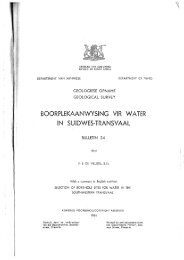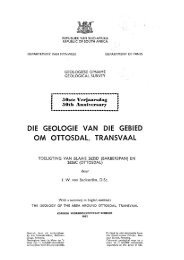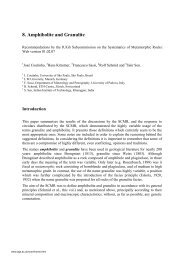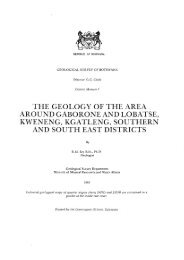Bibliography - British Geological Survey
Bibliography - British Geological Survey
Bibliography - British Geological Survey
You also want an ePaper? Increase the reach of your titles
YUMPU automatically turns print PDFs into web optimized ePapers that Google loves.
Robertson, E. 1984. Hen’s teeth and horse’s toes. Teilhard Review, 19 (2), 65–67. (A response to Gould)<br />
Roland, N. 1992 (contribution to discussion in Tobias 1992c)<br />
Runnels, C. 1992 (contribution to discussion in Tobias 1992c)<br />
Russell, M. 1999. Of flint mines and fossil men: the Lavant Caves deception. Oxford Journal of<br />
Archaeology, 19, 497–500. (Charles Dawson appears to have introduced spurious artefactual evidence into<br />
the Lavant underground chalk workings during the course of excavation. Nothing was formally published<br />
and the caves were afterwards permanently sealed.)<br />
Russell, M. 2003. Piltdown man: the secret life of Charles Dawson and the world’s greatest archaeological<br />
hoax. Stroud: Tempus, 288 pp. (Some 33 cases involving Dawson are examined for evidence of fraud.<br />
Many of these can be dismissed as mild plagiarism, misidentification, over-imagination, sloppiness or<br />
naivety on Dawson’s part. Even where fraud is suspected, there are surprisingly few instances where it can<br />
be definitely proven. The book suffers a little from inadequate proof reading and omitted citations, but is the<br />
most detailed published record of Dawson’s dodgy and sometimes dastardly dealings. The following cases<br />
are examined: Regarding Russell’s crucial assessment of the molar tooth of Plagiaulax dawsoni, it is by no<br />
means clear where he derives his evidence for ‘artificial’ abrasion, since the crown of the tooth has long<br />
been lost, e.g. Clemens 1963. Woodward’s original description in 1891 certainly indicates that the tooth,<br />
when complete, exhibited severe wear; see also Simpson 1928. See book review by Currant 2004.)<br />
Russell, M. 2012. The Piltdown Man hoax: case closed. Stroud: The History Press, 157 pp. (This is a<br />
rather more successful reworking of Russell 2003, including additional matter.)<br />
Russo, F. 1974. Supercherie de Piltdown: Teilhard de Chardin et Dawson. La Recherche, 5, no. 43, 293.<br />
Rutot, A. L. 1913. Nouvelles découvertes relatives à l’homme du Sussex (Eoanthropus Dawsoni). Bulletin<br />
de la Société Belge de Géologie, de Paléontologie et d’Hydrologie, 27 (Nov), 182–184.<br />
Rutot, A. L. 1919. Un essai de reconstitution plastiques des races humaines primitives. Bruxelles: Mém.<br />
Beaux-Arts Acad. Royale Belgique. (This work may include a photograph of a bust of Eoanthropus<br />
modelled by Louis Rutot and the sculptor M. Masere. Rutot wrote to Smith Woodward in July 1914 with<br />
respect to this reconstruction, on which he was then working; see Spencer 1990b, 110–111)<br />
Salter, E. M. & Kolar, J. C. 1993. Skeletal biology in the twentieth century: from Piltdown to the present.<br />
Reviews in Anthropology, 22, 153–164.<br />
Salzmann, L. F. 1908. Excavations at Pevensey, 1906-7. Sussex Archaeological Collections, 51, 99–114,<br />
plates 9–16 (2 folded). (Records the discovery of a fragment of blue black tile or brick, stamped with an<br />
inscription ( ON AVG NDR ) which is incomplete, but can be compared with a perfect example from the<br />
same stamp in the possession of Charles Dawson, HON AVG ANDRIA, pp. 111–113. See Dawson 1907.<br />
These brick-stamps are now known to be modern forgeries (Peacock 1973). Russell 2003, 97–107, devotes<br />
a whole chapter to the Pevensey bricks.)<br />
[Salzmann, L. F.] 1910. Notices of books relating to Sussex: The History of Hastings Castle and Rape, by<br />
C. Dawson, F.S.A. Sussex Archaeological Collections, 53, 282. (The reviewer remarks that this new work<br />
‘contains a great deal of material relating to East Sussex mingled with a certain amount of general history,<br />
not always accurate... The author has displayed much industry in collecting material but little judgement in<br />
its selection and arrangement. Apart from errors of translation the misreadings are extremely numerous. It is<br />
difficult to say how far these are due to carelessness, inaccuracy and neglect of proof reading, and how far to<br />
reliance upon second-hand authorities, as references are frequently omitted or given in an unintelligible form.<br />
In many cases when matter is taken, mistakes and all, from earlier writers no acknowledgment of the source<br />
is made...’)<br />
Salzman, L. F. 1946. A history of the Sussex Archaeological Society. Sussex Archaeological Collections,<br />
85, 2–76. (Makes reference to Dawson’s acquisition of Castle Lodge in 1903, noting that it was ‘entirely<br />
unexpected and naturally caused something like consternation. It was ultimately to prove highly beneficial<br />
to the Society, but for the moment the blessing was very thoroughly disguised.’ In a footnote to this account,<br />
p. 38, Salzman takes a swipe at Dawson with remark that ‘His name was later given to the ‘Pilt Down Man’<br />
(Eoanthropus dawsoni), the lowest known form of human being, with the discovery of whose remains he<br />
was associated.’ This footnote constitutes the only reference in Salzman’s history to the most important<br />
archaeological ‘discovery’ made in Sussex up to that time! A photograph of ‘L. F. Salzman, F.S.A. / Hon.


